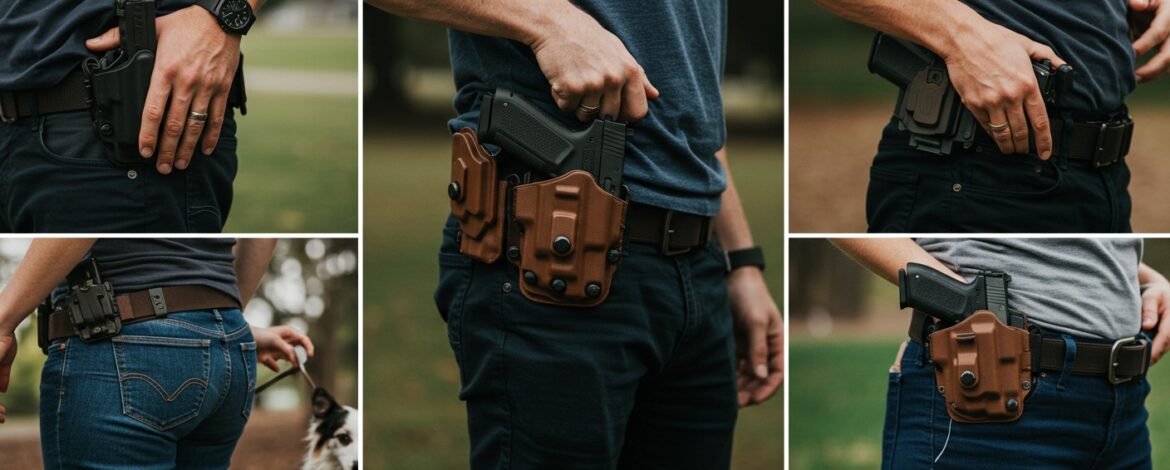Choosing the right holster material is just as important as selecting your firearm. The material affects comfort, retention, durability, and how well your holster performs in South Africa’s diverse climate conditions. Whether you’re carrying for personal protection in Johannesburg or working security in Cape Town’s humid coastal environment, understanding holster materials helps you make an informed decision.
Kydex: The Modern Workhorse
Kydex is a thermoplastic material that’s moulded to fit specific firearm models. It’s become the default choice for many carriers, and for good reason.
Advantages: Kydex offers exceptional retention – you can adjust how tightly it grips your firearm using screws. It’s completely waterproof and unaffected by South Africa’s temperature extremes, from Gauteng’s dry heat to the Western Cape’s winter rain. Maintenance is minimal: wipe it down occasionally and you’re done. Kydex holsters maintain their shape indefinitely and provide a consistent, audible click when your firearm is properly seated. Re-holstering is smooth and doesn’t require you to hold the holster open.
Disadvantages: Kydex is rigid and can be uncomfortable against your body, especially when sitting or bending. The hard edges can dig into your side during long carry periods. It’s also noisy – that satisfying click when holstering can be loud in quiet environments. Kydex can scratch your firearm’s finish over time, though most carriers consider this normal wear. In direct sunlight on a hot day, Kydex can become uncomfortably warm.
Best for: Active lifestyles, security professionals, anyone prioritising retention and quick draw. Ideal if you need something that works reliably regardless of weather or if you carry in varied conditions.
Leather: Traditional Comfort
Leather holsters have carried firearms for over a century. Quality leather remains popular for good reason, offering unmatched comfort and a classic aesthetic.
Advantages: Leather moulds to your body over time, becoming increasingly comfortable. It’s softer against your skin and clothing, making all-day carry more pleasant. Premium leather holsters are often beautiful, with detailed tooling and craftsmanship. They’re quieter than Kydex during draw and re-holstering. Quality leather also protects your firearm’s finish better than hard materials.
Disadvantages: Leather requires regular maintenance – conditioning to prevent drying and cracking, especially in South Africa’s harsh sun. It’s susceptible to moisture damage; sweat, humidity, and rain can cause leather to soften, lose retention, or deteriorate. Leather holsters can collapse after drawing, making one-handed re-holstering difficult or impossible. They also “break in” over time, which means retention decreases – what fits snugly when new may become loose after months of use. Leather is slower to draw from initially and requires more force to re-holster.
Best for: Concealed carriers prioritising comfort over quick access, those in climate-controlled environments, collectors who appreciate craftsmanship. Suitable for occasional carry or situations where maximum comfort matters more than tactical performance.
Hybrid: The Compromise
Hybrid holsters combine materials – typically a Kydex or polymer shell for firearm retention with a leather or synthetic backing against your body.
Advantages: Hybrids attempt to deliver the best of both worlds: Kydex’s excellent retention and weather resistance with leather’s comfort against your skin. The backing spreads the firearm’s weight over a larger area, reducing pressure points. Many people find hybrids more comfortable for extended carry than pure Kydex, especially for larger firearms. The Kydex shell maintains its shape for easy re-holstering while the soft backing protects your body.
Disadvantages: Hybrid holsters are typically bulkier than single-material options, making them harder to conceal. They’re often more expensive due to complex construction. The backing material (whether leather or synthetic) still requires some maintenance and can trap sweat against your body. Some hybrid designs have retention issues if the materials separate or the backing compresses over time. They tend to be heavier than comparable Kydex-only holsters.
Best for: Carriers seeking comfort for larger firearms, those transitioning from leather who aren’t ready for full Kydex, anyone doing extended daily carry in business attire. Good middle-ground for people who found pure Kydex too uncomfortable but need better retention than leather provides.
Matching Material to Your Lifestyle
Office workers and business professionals often prefer leather or hybrid holsters for superior comfort during long periods of sitting. The softer materials work better under tucked shirts and formal wear.
Security personnel and active carriers typically choose Kydex for its reliability, retention, and low maintenance. If your carry involves physical activity, varied weather, or potential defensive situations, Kydex’s consistency matters.
Casual or occasional carriers might find leather’s comfort worth the maintenance trade-off, especially if carrying lighter firearms for shorter periods.
Climate considerations are significant in South Africa. Coastal regions with high humidity favour Kydex’s moisture resistance. Inland areas with extreme temperature swings and intense UV exposure can be hard on leather, requiring diligent maintenance.
The right holster material depends on your specific carry situation, body type, clothing, and climate. Many experienced carriers own multiple holsters in different materials, choosing based on daily activities. Your first holster probably won’t be your last – and that’s perfectly normal as you discover your carry preferences.

